[/caption]
Christa McAuliffe’s life tragically ended on January 28th, 1986 when Space Shuttle Challenger exploded 73 seconds after launch, killing all seven crewmembers. She was about to make history, becoming the first teacher in space, giving unique lessons from orbit to students back on Earth. McAuliffe never had the chance to fulfill her dream of teaching from space and in the aftermath of the accident, her lesson plans were filed away by NASA with sadness and grief. The lessons were incomplete, unfinished, and most regrettably, they were never were taught. But now, 22 years later, the lessons are alive again, brought back to life by NASA engineer Jerry Woodfill who says he came across McAuliffe’s lessons by accident.
Woodfill has worked for NASA for 43 years as an electrical engineer. Most notably, he helped design the alarm system for the Apollo program. So, on Apollo 13 when Jim Lovell said, “Houston, we’ve had a problem,” Woodfill was monitoring the spacecraft.
But in 1989 Woodfill joined the New Initiatives Office, where NASA employees were asked to come up with new concepts on how to make NASA information public and easily accessible. This was about the time that PC’s and Macs were becoming popular. Woodfill had the idea of taking NASA resources that were public domain, scanning them and putting them on diskettes. He was especially interested in the educational materials NASA had. “In fact, if I hadn’t been an engineer I probably would have enjoyed being a teacher,” he said. “I like to communicate to children and adults as well, especially about science and the space program.”
Woodfill worked on compiling the NASA educational materials, and created the Space Educator’s Handbook. It was on diskettes and free for teachers. Woodfill put the word out and distributed hundreds of them. This wasn’t his day job, however. At that time he was designing concepts for going to Mars or returning to the moon. But he was able to devote some of his working hours to the New Initiatives program and the Space Educator’s Handbook, although he worked on it on his own time as well. He tried to be innovative. “I tried to create a space education encyclopedia with an attitude,” he said. “There are space comic books and coloring books, all kinds of things you wouldn’t find on an erudite space or astronomy site.”
When the internet came into vogue, Woodfill created a website and put the Space Educator’s Handbook online. He tried to keep things up to date, adding new astronaut biographies and educational materials from the various NASA missions. “All this stuff is owned by the American people who pay their taxes to support NASA,” said Woodfill.
But there were a lot of materials for one man to manage it all. “I had file cabinets full of old materials; astronaut biographies, old Toys in Space information and other things on aviation, etc.,” he said. “So last September (2007) I was thinking after working here 43 years, I should try to straighten things up a bit.”
As Woodfill was going through folder after folder of papers he came across an article about 30 pages long that included a study by an education specialist named Bob Mayfield about the Challenger mission. It proposed how Christa McAuliffe’s eight lessons would be performed on orbit.
Woodfill was intrigued. These papers probably hadn’t seen the light of day for over 20 years.
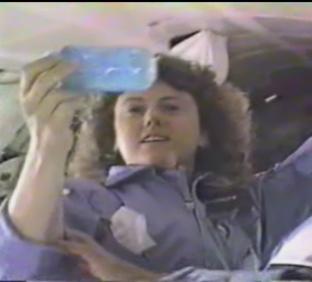
“This article by Bob Mayfield was descriptions only, no sketches or anything,” said Woodfill. “But it was an excellent narrative. He did a wonderful job of writing this, but I’ve never been able to locate him. He went into great detail to consider how these things would work in Zero G, and how the experiments might affect the environment in the crew cabin – if it would be safe. I was so impressed with it. I thought, I’ve always wanted to do something about the fact that Christa and the crew never got to perform those lessons. Challenger was lost and the lessons were lost, too in that tragedy. I thought it would be wonderful if I could resurrect them in some fashion.”
So Woodfill set to work. As good as Mayfield’s narrative was, it was incomplete without McAuliffe’s input of actually doing the lessons in space. Woodfill was trying to piece everything together into cohesive lesson plans that teachers today could use, but it was difficult. At the end of Mayfield’s article was a list of videos that had been shot of McAuliffe, her backup Barbara Morgan, and Mayfield practicing and choreographing how the lessons would be done.
Woodfill thought the videos might be helpful. He started hunting for them, but had a little trouble. These videos would have been recorded in 1985, and 22 years later Woodfill wasn’t even sure they would still be in NASA’s archives. But after a few days of searching, with the help from various people in several different NASA offices, the videos were found.
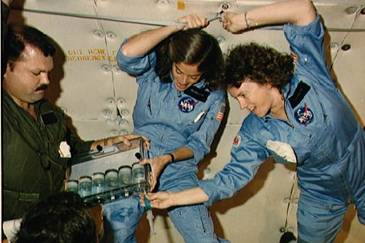
They showed McAuliffe, Morgan and Mayfield, as well as some of the crew including pilot Mike Smith, and mission specialist Judy Resnick practicing the experiments. They were just short snippets, shot 20-30 seconds at a time in a shuttle simulator or in a KC-135 spacecraft (the Vomit Comet) that provided short periods of zero G to test out the procedures. Woodfill converted the videos to DVD and went through 2-3 hours of videos frame by frame to sort everything out.
Using the videos, Bob Mayfield’s paper and his own background in education in creating the Space Educator’s Handbook, Woodfill began re-creating the lessons for classroom use. Woodfill worked on the project for three months, 2-4 hours a day, some of it after hours on his own time. “I had a desire to see Christa’s work brought back to life,” he said. “There was pride, but there’s sadness and a real loss comes through because you see the crew and you remember that they didn’t survive. That motivated and drove me. It was kind of heart wrenching to work on it.”

Woodfill said Mayfield’s paper covered about 15-20 per cent of all the information needed. The other 80 per cent Woodfill had to re-create. “Bob had a goal for each lesson, but I had to find the theory behind each lesson and create the materials lists, step by step processes, what the results might be and follow-up questions.
For example in the hydroponics lesson, Mayfield described it, but Woodfill had to go to the video and enlarge the frames and examine it very closely to correlate everything. Woodfill added sketches, and since there weren’t any high resolution photos of McAuliffe practicing her lessons, Woodfill captured a few good screen shots from the videos.
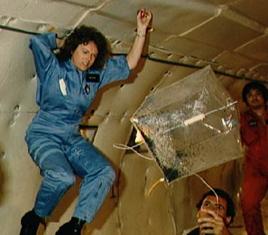
Finally, when Woodfill finished putting everything together, he decided the best place for these lessons would be with the Challenger Learning Center, the educational centers created in memory of the Challenger crew. He sent out the completed lessons to a few of the 50 Challenger Centers, including to Rita Karl, the Director of Educational Programs at the Challenger Learning Center headquarters in Virginia.
“As you can imagine, I’ve been looking for these lessons my entire career,” said Karl, who was familiar with Woodfill from his Space Educator’s Handbook. “For Jerry to actually work with the material that was available and put these lessons together in a way that teachers could use it was really wonderful. As soon as we saw them, we immediately asked if we could host the lessons on our website.”
The lessons are now complete and available on the Challenger Center website for teachers and students around the world to use and experience what McAuliffe undoubtedly wanted to share from space.
“These lessons are really perfect for teachers who are trying to recognize the Teacher in Space mission, both Christa’s and Barbara’s and also for getting kids interested in science, technology, engineering and mathematics,” said Karl. “That’s what the Challenger families intended when they started the Challenger Center. Personally, this is a great moment, as if everything has come full circle to get these lessons available online.”
The Challenger Center recently put out a press release to let teachers know the “Challenger Lost Lessons,” as they are called, are now available. “It’s exciting to see teachers starting to use the lessons, and hopefully by the end of the year we’ll have some really good feedback. My feeling is that Christa’s lessons will be really popular,” said Karl.
Included with the lessons are clips taken from the videos of McAuliffe practicing her lessons from space.
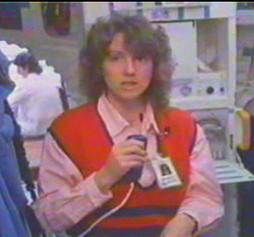
“If you watch the videos, Christa’s personality and her excitement really come through,” said Woodfill. “I got to know her from working with this. You really see what a bright person she was and how innovative she was. You can see all the things she contributed to the performance of the lessons.”
Woodfill says he has received calls and emails from many people, including Barbara Morgan, thanking him for his efforts in bringing back the Lost Lessons. “It’s remarkable that I came across them,” said Woodfill. “I think after the accident, nothing was done with them because Christa never got to teach the lessons from space. But it’s appropriate to do it now, because of the technology available. There’s no way you could have given this kind of treatment of these materials even 15 years ago. But now you can watch the videos and watch Christa perform her lessons. So it does resurrect them, it really does. It’s Christa’s work and it gives honor to her.”
Thanks to Woodfill, McAuliffe’s often-used quote of “I touch the future, I teach” was never more true.
Below is the Challenger Center’s video about the Lost Lessons:

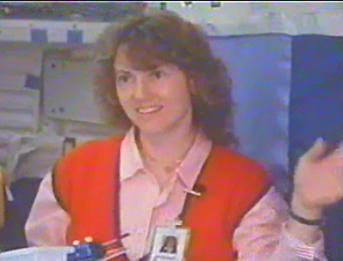
Wow, such a moving and unexpected story. It’s wonderful that these lessons have been rediscovered. A true legacy.
Nice one Nancy 🙂
Cheers, Ian
Thanks, Nancy. I’ll make sure to share this with the teachers I know.
Ditto Ian’s sentiments. Thanks Nancy for posting this poignant story & the links provided for this moving tribute.
It should be a nice idea, send in one of the last shuttles a new teacher to finish what Christa started.
Should be a nice way to remember all the people that died in Challenger and Columbia.
And because Christa always has been the “space spirit” of all humankind (not only in the USA). She represented the hope of all people who dreamed to touch the stars not being an astronaut, and saw Christa as one of them.
She was a normal person, just like us.
And it just made her more special than any other astronaut.
A piece of all humans heart fell down with the Challenger that day. Let’s fix that.
A day I will never forget.
If I’m not mistaken I believe she would have been the first American civilian in space. While the story centers on here deserved legacy. Lets not forget the others who have given their lives.
Troy, I too will never forget that tragic day, nor my pleasant association with one of the most remarkable astronauts I met while working at the Shuttle Simulation Facility at JSC , Ellison Onizuka, the “Happy Budda”, whose demise that sad day has been largely ignored due the focus on Christa and others afterward. I believe anyone who had ever met Ellison would agree with me that his demeanor exemplified peace and serenity to a degree seldom encountered in this world.
May he always be remembered, as well as Mr. Woodfill for his desire and efforts in behalf of Christa. Good job. 🙂
I would just like to say that we will always remember the Challenger Crew and the Columbia Crew forever and ever since 1980 to 2008. But they will always stay in our hearts-and-souls. But mostly in our memory and are thoughts. That we will never forget them for those who knew them just like at NASA in Houston, Texas and because they worked with them very closely I know how they felt. The most important thing is that we should all know is that they accomplished all that they wanted to succeed in and that how they passed away is already happened and THEY TOUCHED THE FACE OF OUR HEAVENLY LORD JESUS CHRIST AND OUR SAVIOUR GOD AND THAT THEY ARE ALREADY HOME WITH THE LORD JESUS CHRIST AND GOD “Jesus Christ Superstar, This Song Reminds Me Of The Challenger Crew And The Columbia Crew Especially Christa M. “Superstar” And Also “Gethsemane(I Only Want To Say)”,. Every time I think about (Romie) them I start to cry in tears because I can feel for the Familys even if they have started a whole new lifes from all these years 1980-2008. Just like their beloved ones wanted them to do start a new life. Good Job To All Of You !!!! Thank You !!!!